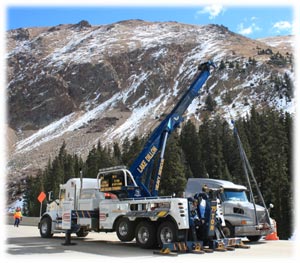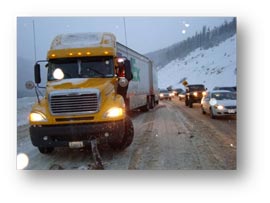Heavy Tow Program Lightens Congestion
 Faced with chronic congestion, peak winter travel days, colossal winter storms and varying elevations, the I-70 Ski corridor can be a challenging roadway for motorists traveling through Colorado, a major east west link. Following the release of a study[1] on the corridor that found congestion on I-70 to cost area businesses, tourists, residents and the government a combined $839 million in lost revenue annually, the Colorado Department of Transportation (CDOT) launched the Heavy Tow Program.
Faced with chronic congestion, peak winter travel days, colossal winter storms and varying elevations, the I-70 Ski corridor can be a challenging roadway for motorists traveling through Colorado, a major east west link. Following the release of a study[1] on the corridor that found congestion on I-70 to cost area businesses, tourists, residents and the government a combined $839 million in lost revenue annually, the Colorado Department of Transportation (CDOT) launched the Heavy Tow Program.
The Heavy Tow Program provides the same essential services as the SSPs, including free assistance, but for commercial trucks along I-70 corridor between Ward Road in Wheat Ridge and Dotsero in Eagle County. The program includes GPS tracking, response platforms (strategic locations where Heavy Tow Service Units (HTSU) await calls for service), safe havens, heavy wreckers, clearance goals and performance incentives to ensure safer driving on the corridor. At least two response platforms are typically chosen each day based on the weather forecast and historical accident patterns.
HTSUs or wreckers staged at specific locations along I-70 replace the previous process of truck incident information starting with the state patrol and ending with the local tow company. The service provides for the quick clearance of the disabled commercial vehicle from the travel portion of the highway to a place of safety outside the highway or “safe haven”. There, the CMV (commercial motor vehicle) can make repairs or get commercially available assistance to get to the top of the grade.
“I have managed this program since its inception in the winter of 2007/8. The use of staged assets to quickly respond to disabled commercial vehicles has increased the safety to all, the responder,  the truck driver and the traveler,” Ken Wissel, Heavy Tow Program Manager and Senior Transportation Specialist at Stantec Consulting Firm, explained. “The quick relocation has made a dramatic difference to the safety and management of the overall corridor. Heavy traffic demands, congestion and associated challenges have been improved from the use of this valuable resource.”
the truck driver and the traveler,” Ken Wissel, Heavy Tow Program Manager and Senior Transportation Specialist at Stantec Consulting Firm, explained. “The quick relocation has made a dramatic difference to the safety and management of the overall corridor. Heavy traffic demands, congestion and associated challenges have been improved from the use of this valuable resource.”
The annual statistics projected by the Heavy Tow Program back Wissel’s statements. Even though the Heavy Tow Program’s one to five wreckers are on the highway under 10% of the time, the 55% decrease in the patrol region queue and the $21 saved for every $1 spent since the program’s inception speaks volumes for the program. Now in its fourth year of operation, the Heavy Tow Program, which runs during the winter months from Thanksgiving to April, has already reduced the average clearance time of 51 minutes to 24 minutes and has saved an average of $24.34 million dollars annually in lost revenue to Colorado’s economy.
[1] Development Research Partners. The Impact of I-70 Congestion on Colorado – Denver to Grand Junction. Colorado, 2007. (On behalf of Denver Metro Chamber of Commerce).
